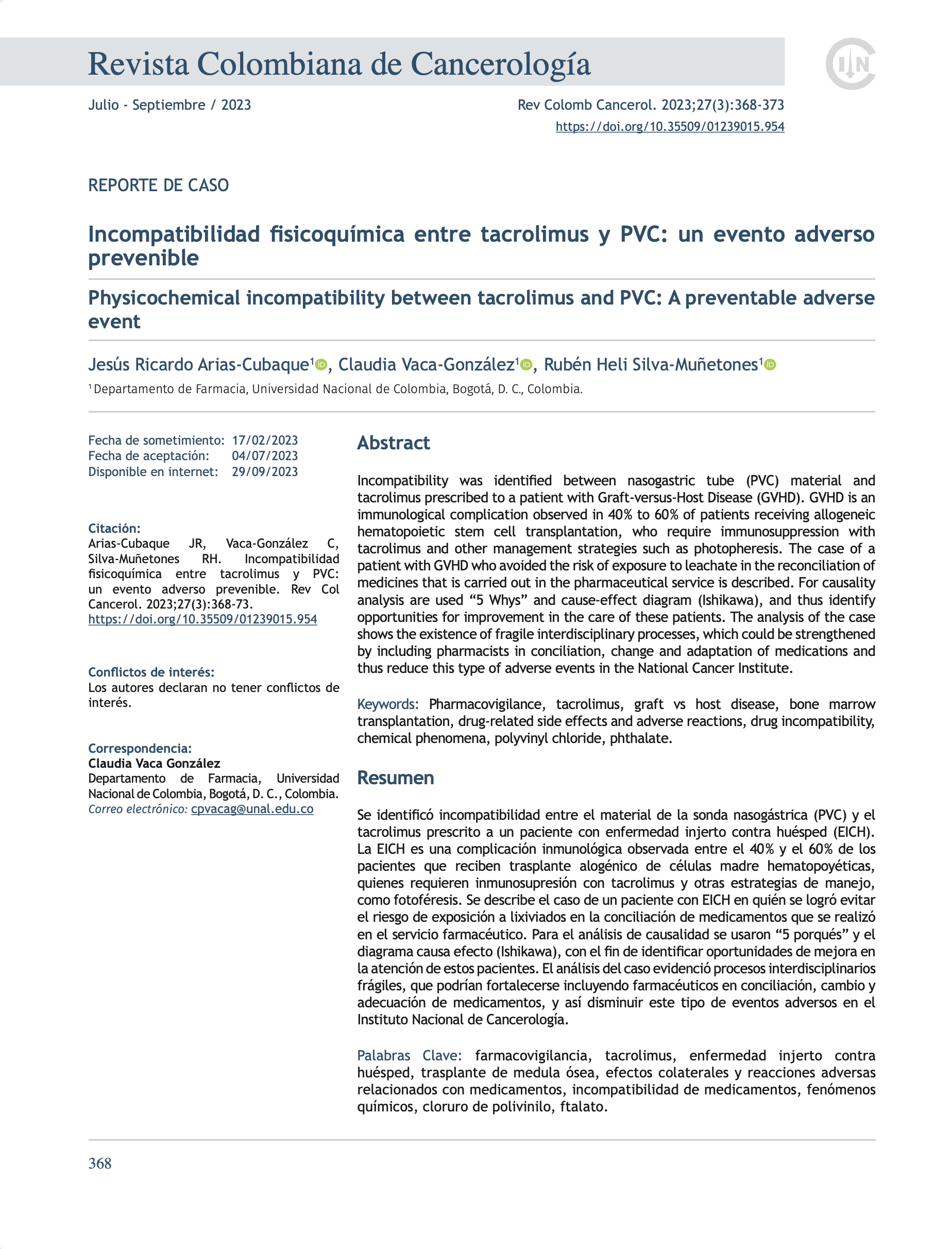Physicochemical incompatibility between tacrolimus and PVC: A preventable adverse event
DOI:
https://doi.org/10.35509/01239015.954Keywords:
Pharmacovigilance, tacrolimus, graft vs host disease, bone marrow transplantation, drug-related side effects and adverse reactions, drug incompatibility, chemical phenomena, polyvinyl chloride, phthalateAbstract
Incompatibility was identified between nasogastric tube (PVC) material and tacrolimus prescribed to a patient with Graft-versus-Host Disease (GVHD). GVHD is an immunological complication observed in 40 % to 60 % of patients receiving allogeneic hematopoietic stem cell transplantation, who require immunosuppression with tacrolimus and other management strategies such as photopheresis. The case of a patient with GVHD who avoided the risk of exposure to leachate in the reconciliation of medicines that is carried out in the pharmaceutical service is described. For causality analysis are used “5 Whys" and cause-effect diagram (Ishikawa), and thus identify opportunities for improvement in the care of these patients. The analysis of the case shows the existence of fragile interdisciplinary processes, which could be strengthened by including pharmacists in conciliation, change and adaptation of medications and thus reduce this type of adverse events in the National Cancer Institute.
Author Biographies
Jesús Ricardo Arias-Cubaque, Departamento de Farmacia, Universidad Nacional de Colombia, Bogotá D. C., Colombia.
1. Departamento de Farmacia, Universidad Nacional de Colombia, Bogotá, D. C., Colombia.
Claudia Patricia Vaca-González, Departamento de Farmacia, Universidad Nacional de Colombia, Bogotá D. C., Colombia.
1. Departamento de Farmacia, Universidad Nacional de Colombia, Bogotá, D. C., Colombia.
Ruben Heli Silva-Muñetones, Departamento de Farmacia, Universidad Nacional de Colombia, Bogotá D. C., Colombia.
1. Departamento de Farmacia, Universidad Nacional de Colombia, Bogotá, D. C., Colombia.
References
Domínguez MA, Rodas-Díaz AC. Enfermedad injerto contra huésped. Rev Cent Dermatol Pascua. 2012;21(3):104-8. Disponible en: https://www.medigraphic.com/pdfs/derma/cd-2012/cd123c.pdf
Al-Kadhimi Z, Gul Z, Chen W, Smith D, Abidi M, Deol A, et al. High incidence of severe acute graft-versus-host disease with tacrolimus and mycophenolate mofetil in a large cohort of related and unrelated allogeneic transplantation patients. Biol Blood Marrow Transplant. 2014;20(7):979-85. http://dx.doi.org/10.1016/j.bbmt.2014.03.016
Ramachandran V, Kolli SS, Strowd LC. Review of graft-versus-host disease. Dermatol Clin. 2019;37(4):569-82. https://doi.org/10.1016/j.det.2019.05.014
Jacobsohn DA, Vogelsang GB. Acute graft versus host disease. Orphanet J Rare Dis. 2007;2(1):35. http://dx.doi.org/10.1186/1750-1172-2-35
Thangavelu G, Blazar BR. Achievement of tolerance induction to prevent acute graft-vs.-host disease. Front Immunol. 2019;10:309. http://dx.doi.org/10.3389/fimmu.2019.00309
Preventing incompatibility in I.V. admixtures. Nursing 1980;10(2):48-9. http://dx.doi.org/10.1097/00152193-198002000-00012
Gooptu M, Koreth J. Better acute graft-versus-host disease outcomes for allogeneic transplant recipients in the modern era: a tacrolimus effect? Haematologica. 2017;102(5):806-8. http://dx.doi.org/10.3324/haematol.2017.165266
Bauters T, Rayner P, Therrien R, Van Lancker S, Bordon V, Le Cordroch M, et al. Practical considerations in the use of intravenous tacrolimus in hematopoietic stem cell transplantation patients. J Oncol Pharm Pract. 2015;21(6):478-80. http://dx.doi.org/10.1177/1078155214531609
Gatza E, Choi SW. Approaches for the prevention of graft-versus-host disease following hematopoietic cell transplantation. Int J Hematol Oncol. 2015;4(3):113-26. http://dx.doi.org/10.2217/ijh.15.13
Instituto Nacional de Vigilancia de Medicamentos y Alimentos. ABC de tecnovigilancia [internet]. 2012 [citado: 2019 nov 20]. Disponible en: https://www.visitaodontologica.com/ARCHIVOS/ARCHIVOS-NORMAS/TECNOVIGILANCIA/ABC-Tecnovigilancia-INVIMA.pdf
Martens HJ, De Goede PN, Van Loenen AC. Sorption of various drugs in polyvinyl chloride, glass, and polyethylene-lined infusion containers. Am J Hosp Pharm. 1990;47(2):369-73. PMID: 2309728.
Jin S-E, Jeon S, Byon H-J, Hwang S-J. Evaluation of tacrolimus sorption to PVC- and non-PVC-based tubes in administration sets: Pump method vs. drip method. Int J Pharm. 2017;528(1-2):172-9. https://doi.org/10.1016/j.ijpharm.2017.05.040
FDA. Highlights of prescribin information: PROGRAF® (tacrolimus) capsules [internet]. 2012 [citado: 2019 nov 26]. Disponible en: https://www.accessdata.fda.gov/drugsatfda_docs/label/2012/050709s031lbl.pdf
The Lowell Center for Sustainable Production at the University of Massachusetts. Phthalates and their alternatives: Health and environmental concerns [internet]. 2011 [citado: 2019 nov 26]. Disponible en: https://www.sustainableproduction.org/downloads/PhthalateAlternatives-January2011.pdf
Center for Devices and Radiological Health-U.S. Food and Drug Administration. Safety assessment of Di(2-ethylhexyl) phthalate (DEHP) released from PVC medical devices [internet]. 2001 [citado: 2019 nov 26]. Disponible en: http://icpe.in/pdf/Safety_assessment_Diphthalate.pdf
How to Cite
Downloads

Downloads
Published
Issue
Section
License
Copyright (c) 2023 Revista Colombiana de Cancerología

This work is licensed under a Creative Commons Attribution-NonCommercial-NoDerivatives 4.0 International License.
Todos los derechos reservados.

| Article metrics | |
|---|---|
| Abstract views | |
| Galley vies | |
| PDF Views | |
| HTML views | |
| Other views | |



